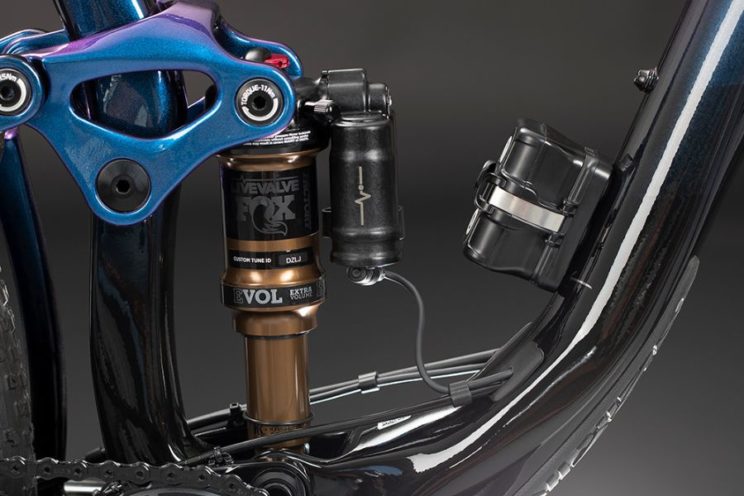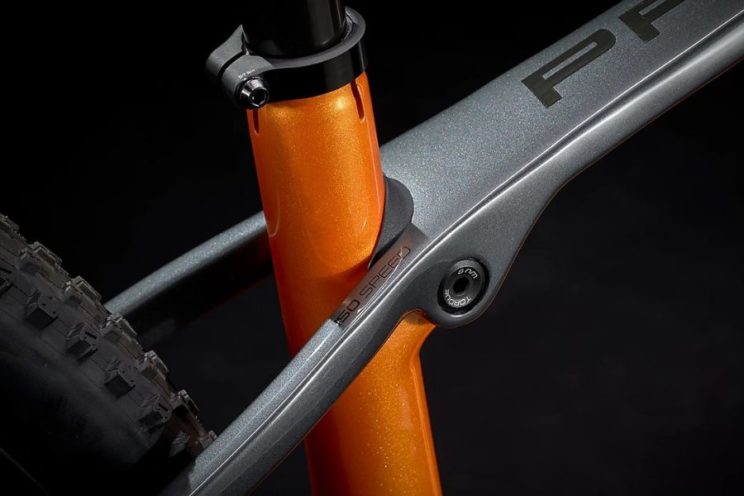Specialized Brain
It is one of the most successful technologies of the Californian brand. He arrived in 2001 with the first Specialized Epic and the collaboration of Fox, and since then he has not abandoned the model or the brand. In more than 20 years of history, it has evolved to become a practical and comfortable blocking technology, which dispenses with the control function in the handlebar. The Brain uses an inertia valve in the hydraulic circuit of the suspension. This default plug valve the oil passage (when it is being pedaling, in plain, climb, etc). But upon receiving an impact from below (stones, potholes), it moves allowing the fluid to pass and the shock absorber is compared (or front suspension fork). Currently, Fox has been replaced by Rockshox for its development. Its size has been considerably reduced and its integration has improved into the rear axle and inside the fork. Also, their adjustment options have increased, offering up to 5 positions.📺 Surely this video interests you: Know Brain technology by the Specialized brand itself. [Embed] https://www.youtube.com/watch?v=MRPN0kms8pm[/embed]
Cannondale Lefty
Let us now talk about another great innovation in suspensions launched to the market at the beginning of the century and that has reached to this day. Cannondale Lefty monobrazo fork continues to call the attention mounted on an F-SI or in a scalpel. This technology dispenses with one of the bottles and bars, reinforcing the one that remains with needle bearings, double plating and investing the suspension bar to gain stiffness and stability. In this way, a controlled and effective absorption is achieved. Currently, Lefty has adopted the last name 8 And it has become a more conventional MTB XC suspension fork, retaining its essence: the monobrazo structure. Now it is much lighter (it almost equals weight with the competition forks Rockshox Sid or Fox 32) and dispenses with the upper double plethine to become compatible with other MTB boxes, beyond the Cannondale brand.Scott Twinloc
It is a suspension blocking technology that allows, at the same time, to change the suspension and geometry route of the bike by just acting a command. From this locking command, with two or three levers, the cyclist can vary up to three positions (descent, traction control and block), also changing the inclination of the angles of the armchair tube or the pedalier height to the ground. To do this, it uses a total connection between the control command, the fork and the shock absorber. Pressing the levers of the open or descent position, one of the two air cameras closes from the suspensions. Thus, the route is reduced (from 120 to 80 mm in the case of the current Spark). It can also be completely closed in the blockade option. Everything is done in unison, in addition to moving the tilting to slightly modify the angle of the armchair and adapt the position of the biker to the ground.📺 Do you feel like knowing more about Scott's Twinloc system? [embed] https://www.youtube.com/watch?v=zMoygyo39FC[/embed]
We can find the Twinloc system in MTB models such as the Scott Spark, Genius, Ransom, or the Scott Genius Eride or Eride Pattern electric.
Trek isostrut
He arrived from Trek Supercaliber in 2019. The competition MTB that, thanks to this technology, retains its structure and behavior of rigid bike with the absorption of a double. For this, it uses a semi -integrated shock absorber in an extension of the braces of the table to the upper tube. A minialling manufactured with the collaboration of Fox, which offers 50 mm travel. It is complemented by the flexion of the structure that houses it to give 10 mm extra.📺 Watch this video to better learn the ISostrut system. [embed] https://www.youtube.com/watch?v=-mlk2rqdrjy[/embed]
With this system, up to 700 grams are saved with respect to the double classic brand of the brand, the top fuel. In addition, the design of wide and plans of this supercaliber allows vertically flexing the painting in this area, together with the shock absorber, to absorb irregularities of the land and obtain a better and more comfortable response from the bike in technical sections. In addition to Trek Supercaliber, this system has spread to its electric variant called Trek e-Caliber.
Rockshox Flight Attendant
Several Rockshox's attempts to move towards autonomous suspensions in recent years have been; That is, controlled with electronics and not manually, with controls or dials. And it seems that since 2021 he is getting him with his Flight Attendant. It is a system that uses SRAM's AX technology (owner group of rockshox) to implement it in the control and adjustment of the suspension. Thus, the new electronic suspension dispenses with the adjustments, having to acquire the electronic versions (with integrated control modules) of the forks and shock absorbers, which will be connected (via via Wireless) to a sensor installed on the pedalier axis.The Flight Attendant takes advantage of the wireless SRAM AX technology to eliminate cables.Thus, the suspension will harden or open depending on the state of the land, which will capture and interpret the pedalier axis sensor. But also, from the modules of the suspensions themselves, several modes of operation can be chosen, to customize them to the taste of the biker: car, normal (manual) or override (rapid change). At the moment, this technology is only available in long -distance suspensions of Rockshox, for trail or enduro, mainly.
Fox Live Valve
Similar system developed by Fox in its suspensions: the new generation Live Valve. Only this system continues to rely on cable connections to give, both to fork and shock absorber, an autonomous and intelligent operation. [Captation Id = "Attachment_8379" Align = "Alignnone" Width = "744"] Image: Live Valve System (Fox).[/caption]
This means that the cyclist should not block or open the suspension manually when he needs it. Thanks to a special valve integrated in each of the suspensions and a sensor, the bike is capable of read The type of land for which it rolls. In a matter of milliseconds, the sensor sends the information to a central controller, installed on the diagonal tube of the table. Just after, he issues the order to open or close the hydraulic cartridge to activate or block the suspension what is necessary.
Image: Live Valve System (Fox).[/caption]
This means that the cyclist should not block or open the suspension manually when he needs it. Thanks to a special valve integrated in each of the suspensions and a sensor, the bike is capable of read The type of land for which it rolls. In a matter of milliseconds, the sensor sends the information to a central controller, installed on the diagonal tube of the table. Just after, he issues the order to open or close the hydraulic cartridge to activate or block the suspension what is necessary.
Fox Live Valve can only be found in certain bicycles, prepared for installation.The entire system works by a rechargeable lithium battery, installed inside the controller, with an estimated autonomy of between 16 and 20 hours. However, the main barrier to its large -scale popularization comes for its high price, around 2,000 euros, and its availability only in certain serial assemblies and for certain prepared bicycles. Currently, Giant and Liv are associated with Fox and offers models such as Trance X, Reign or Anthem Advanced with Live Valve standard.
Electronic suspension Sr Sustour
We finish the chapter of electronic suspensions with the system of a mythical brand such as Sr Sustour, still in the prototype phase. Because of the little that has been seen in photos in the bike of the current MTB Olympic champion, the British Tom Pidcock seems like a system similar to Fox Live Valve, although in this no movement sensors are intuited in the fork and the shock absorber; All work seems to do it autonomously, or with integrated sensors. We will have to be attentive: will it finally get to the market? Will it be limited to the competition?📺 Do not miss this video to know better the technology developed by SR Sustour. [embed] https://www.youtube.com/watch?v=ej9gltheco[/embed]
Integrated suspensions: Scott-Bold and Cannondale
Technology and current bike designs walk towards the integration of elements. Cables, screws and other parts of the B has only developed for the competition. The shock absorbers, rather heavy and rough components, have already managed to integrate into the painting thanks to technologies developed by Scott or Cannondale. In the first case, the Switzerland Bold really was the first to present mountain bikes with integrated shock absorbers, back in 2015. A ingenuity that caught the attention of a giant like Scott to buy and share part of the patent with this brand. In this way, Scott also integrated the spark shock (or the new e-bike pattern) inside the armchair or diagonal tube tube.Bold was the first brand to produce Mountain Bikes with a shock absorber inside the box, back in 2015Cannondale is another brand that, recently, has tried to integrate the shock absorber to improve the behavior of the suspension and win in aesthetics. The result, the launch of its new Enduro Bike: the Jekyll. Unlike Bold-Scott solution, Cannondale leaves the shock absorber partially and more accessible, to facilitate adjustments. But it is still a component installed within the structure of the table (within the diagonal tube). In addition, this new location implies demonstrated improvements in the kinematics of the suspension and distributes its weight to improve the stability of the bike.
Other technologies: microsuspensions and elastomeres
The integration of the suspension into the bike itself is not something new. Already in the 1990s, numerous systems were tested that melted painting and suspension, with some success in some cases. Cannondale Headshock Management shocker, precedent of the Lefty, is one of them. Likewise, the popularization of the wheels of 29 '' with increasingly light and rigid carbon pictures brought the introduction of more flexible elastomers or materials in key areas the bike to provide some absorption. This is the case of the Lapierre SAT system or MTT microsuspension in the Rigid MTB of BMC, rescued today by its new Bike of Grave Urs LT.Microsuspensions, originally in rigid MTB, resurface today in Grave and highway models.They are much lighter systems than a conventional shock absorber or fork. In addition, they allow flexing and absorbing small potholes and vibrations for more comfort, and without excessive weight gain. Another success system in recent years has been the Trek isospeed. A small cap that joins the horizontal tube and the armchair and that has autonomy to provide some flexion in the area. It is carried by the current highway Trek Domane, both under the armchair and in the direction, or the MTB Trek Pro Caliber. [Captation Id = "Attachment_8381" Align = "Alignnone" Width = "744"]
 Image: Trek isospeed system.[/caption]
There are other successful road bicycles with microsuspensions, such as the Specialized Roubaix with the Future Shock Management shock, which also has the Specialized Diverge of Gravel. Or the Topstone Carbon Cannondale of Gravel, with the Kingpin system with flexible braces and a turn point in the union of braces with the front triangle.
Image: Trek isospeed system.[/caption]
There are other successful road bicycles with microsuspensions, such as the Specialized Roubaix with the Future Shock Management shock, which also has the Specialized Diverge of Gravel. Or the Topstone Carbon Cannondale of Gravel, with the Kingpin system with flexible braces and a turn point in the union of braces with the front triangle.












